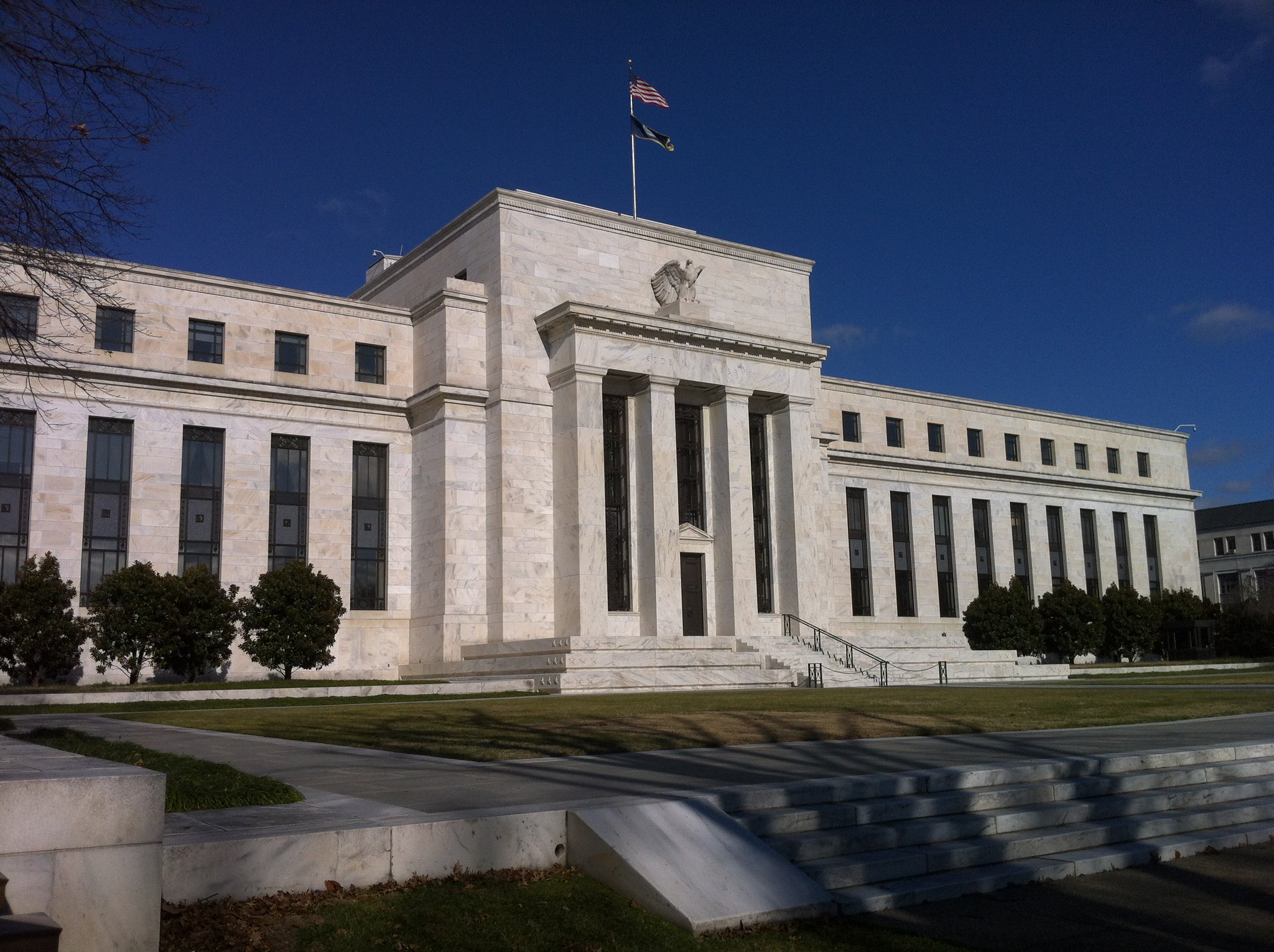Макроэкономический взгляд за сентябрь 2024 года

Eugeniu Kireu, CFA
Oct 21, 2024В сентябре наиболее важным макроэкономическим событием стало снижение процентной ставки в США с 5,5 до 5%. Важным оно является в первую очередь потому, что ставка не снижалась уже 2,5 года и оставалась на пиковом значении для этого цикла роста почти 14 месяцев. Этот срок оказался значительно более долгим, чем ожидали аналитики и почти таким же продолжительным, как срок сохранения высокой ставки перед финансовым кризисом 2007 года. Тогда она выросла до уровня 5,25% и продержалась там лишь на 26 дней дольше, чем в нынешнем цикле ужесточения монетарной политики. Снижение и в сентябре 2007 года и в сентябре 2024-го составило сразу 50 б.п., однако условия, в которых произошло снижение, заметно различаются. К сентябрю 2007 года ипотечный кризис уже разворачивался не менее полугода, цены на жилье уже ощутимо упали, а значительное число субстандартных кредиторов обанкротилось. Сейчас же нет острых или достаточно масштабных проблем в финансовой системе, которые бы могли указывать на разворачивающийся кредитный кризис, и снижение ставки происходит в условиях довольно устойчивого экономического роста и рынка труда.
Инфляция в США остается несколько выше цели ФРС и составляет 2,4% по итогам двенадцати месяцев, оканчивающихся в сентябре. Базовая инфляция пока относительно высока — на уровне 3,3% — но стабильна. Дезинфляция, которую мы наблюдали в середине года, приостановилась, хотя вклад энергии в рост общего уровня цен по-прежнему отрицательный. Экономика США прибавила 254 тыс. рабочих мест, превысив большинство прогнозов аналитиков. Уровень безработицы также снизился до 4,1%, что пока не подтверждает опасений ФРС насчет роста показателя к концу года до 4,4%.
В то же время уровень доверия инвесторов и аналитиков к статистике по рынку труда и ее релевантности значительно ниже, чем раньше. Это вызвано многими факторами, в том числе частым пересмотром показателей вниз, значительной нелегальной миграцией в США и преобладанием роста рабочих мест в государственном секторе (за последний год госсектор создавал новые рабочие места темпом в 1,6 раза бо́льшим, чем частный). В то же время, несмотря на продолжающееся увеличение количества рабочих мест, рост заработной платы не слишком высок, если учитывать выросшую производительность труда. За последний год вознаграждение увеличилось в среднем на 4%, что ниже совокупного роста инфляции и производительности труда (оценка за второй квартал показывала повышение производительности на 2,7% за предшествующие 12 месяцев). Это означает, что, несмотря на рост спроса на труд, нет причин для того, чтобы инфляция разгонялась из-за заработной платы.
Одновременно оценки показывают, что избыточные сбережения населения исчерпаны, а кредитная нагрузка в целом вернулась к уровням, сопоставимым с периодом перед пандемией. Пока реальные процентные ставки остаются относительно высокими, объемы кредитования вряд ли увеличатся настолько, чтобы послужить причиной ускорения роста совокупного спроса и инфляции. Стабильность совокупного предложения менее предсказуема в силу существенного влияния на него глобальных экономических и политических факторов. В то же время слабость мировой экономики в сравнении с США не дает причин ожидать резкого роста спроса на сырье и сопутствующего роста цен. Экономика Китая, несмотря на существенные монетарные и фискальные стимулы, все еще испытывает серьезные проблемы. Иностранные прямые инвестиции быстро сокращаются. Цены на жилье падают, а рынок акций, несмотря на недавний рост, все еще котируется очень низко по историческим меркам. Цены на новое жилье в сентябре опустились на 5,3% ниже уровня годовой давности, и явного разворота в их динамике нет, даже с учетом стимулов правительства. При этом проблемы на рынке жилья значительно важнее для китайцев, капитал которых в отличие от жителей США концентрируется в первую очередь в недвижимости, а не в акциях или других ценных бумагах. Помимо этого, нет веских причин для роста инфляции из-за шока совокупного предложения. Цепочки поставок не нарушены, а локальные военные конфликты пока не достигли той степени эскалации, которая бы неизбежно привела к проблемам на энергетических или продовольственных рынках. Ситуация вокруг Тайваня, при всей напряженности из-за военных учений Китая, пока остается без явной эскалации, исходящей от какой-либо из вовлеченных в противостояние сторон. Действия Северной Кореи на границе с Южной Кореей, такие как подрыв приграничных дорог, не способствуют деэскалации, но вряд ли свидетельствуют о каких-либо явных военных угрозах для последней.
В итоге, рассуждая о перспективах экономики США и инфляции, можно с определенной долей уверенности сказать, что, пока реальные ставки довольно высокие и нет явных сдвигов в балансе совокупного спроса и предложения, инфляция, хоть и медленно, должна продолжить снижение. Конечно, это состояние сильно зависит от того, как будут изменяться все вышеописанные внутренние и внешние экономические факторы. Есть ощутимые риски того, что смена президента США приведет к изменению макроэкономического статус-кво, однако и исход выборов, и возможную степень исполнения предвыборных обещаний нельзя с достаточной уверенностью предсказать. То же касается и эскалации военных конфликтов и глобальной финансовой системы в целом, частью которой является Китай, испытывающий серьезные структурные проблемы.
Одновременно с этим рисковые активы, особенно на рынках США, остаются очень дорогими по историческим меркам. Кредитные спреды практически не сдвинулись с уровней, близких к историческим минимумам, а премия за риск на рынке акций, по разным оценкам, либо существенно ниже, либо вблизи уровней, предшествовавших последним мировым экономическим кризисам. Сохранение высоких ставок из-за устойчивости экономики США скорее повышает риск ее жесткой посадки из-за усиления проблем в слабых секторах экономики и финансовой системы. Компании с плохим кредитным качеством, активно занимавшие при нулевых процентных ставках в 2020 и 2021 годах, вскоре должны будут массово рефинансировать долг. Сохранение высоких ставок может оказаться существенной проблемой и для компаний, и для держателей такого долга. Дороговизна рисковых активов с одновременно высокими по меркам последних десятилетий безрисковыми реальными ставками и наличием событий, которые могут стать катализатором смены текущей парадигмы и коррекции цен активов, на мой взгляд, скорее поддерживают идею о разумной осторожности, чем страх об упущенной потенциальной выгоде.


